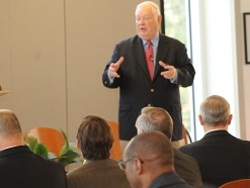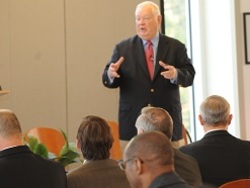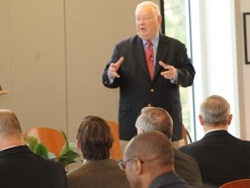


Without risk there is generally scant reward. That truism hit home when I was invited to make a presentation at an international conference in Amsterdam, Holland. The presentation was to be simultaneously translated in three languages. I expected about 100 people in each of my four sessions on four different topics – leadership, problem-solving, training techniques, and marketing strategies.
I received much pre-presentation advice from people familiar with the conference. My group involvement techniques, according to these people, wouldn’t work well when applied to people speaking different languages. And the more reserved Europeans, they said, expect formal presentations; they would turn their noses up at a suggestion to openly participate in the manner American groups do. They also suggested I drop most of my American-based illustrations and anecdotes, implying they would get lost in the cross-cultural abyss.
Some of the advice I accepted, most I disregarded. For years, I’ve championed participation and involvement in my train-the-trainer sessions. Why couldn’t participation transcend language barriers and cultural differences? Why couldn’t illustrations be created with cross-cultural applications?
I began my first presentation with a mini-lecture – as the Europeans expected. But then I chose to reorganize into small groups to facilitate networking. I took into account language differences by having all those listening in English number off together, and so on for those listening in French, Spanish, and Japanese. That mixed the groups, but allowed participants to remain working in a language they felt comfortable with.
Earlier, I had assessed each of the anecdotes, analogies and illustrations I planned to use. In my discussion on effective leadership skills, I asked myself if the group would identify with American leaders such as John Kennedy and Lee Iacocca and draw parallels to leaders in their own countries and organizations. Each country and each company is divided into those people that take charge and those that stay in the background. I found the examples transferred well, as did those about leadership in families. I found my group size grew progressively as the conference continued.
Relying more on natural humor than structured jokes was effective because natural humor doesn’t promise first to be funny, but rather catches an audience by surprise (although it was unusual hearing one part of the room laugh 30 seconds after another as translated versions were delivered). Most people identify with natural, spontaneous humor because of its true-to-life nature.
The point is that people everywhere can identify with illustrations drawn from real-life episodes. We all work with people and sometimes misunderstand each other. We all experience the same emotions, from elation to melancholy to despair, over similar issues. I’ve found people all over the world love to be involved and to share their unique experiences if doing so makes good sense and isn’t contrived or manipulated.
It’s true in our own organizations. People from the stockroom to the boardroom are willing to be involved and participate, but only if they see the participation having true value to them. I took what I thought to be some risks in Amsterdam, but discovered that when it comes to using involvement, real world illustrations, and unassuming humor, the risks are generally small and the rewards great.
Don't miss out on updates and chances
to sharpen your skills with participant-centered learning.




3740 N Chestnut St #113 - Chaska, MN 55318-3053